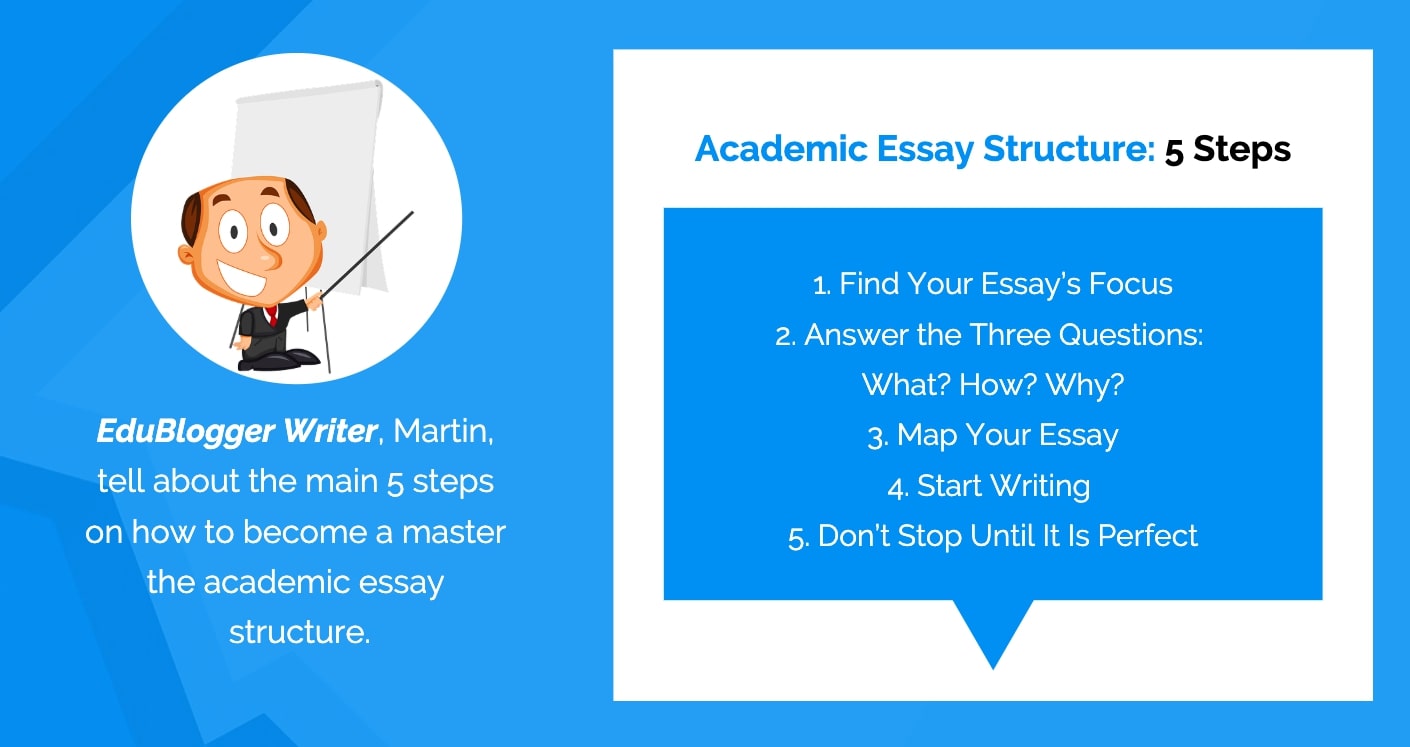Writing is a highly valued academic scholarly skill. At this point in education on a global level, possessing such skills is essential for the performance of a student. Not only are students required to attend classes and pass the exams at the end of each term, but they are also given a myriad of essays to write. The goal of all these essays is the same – to determine their knowledge and hone their writing skills.
To get a high grade at school, you need to master the academic essay structure. Here is advice from EduBlogger on how you do it.
Step 1: Find Your Essay’s Focus
Every academic essay has a focus. The focus of a paper represents the starting point on which the writer builds the essay structure and sentence flow. To be able to write this type of paper following the required academic essay structure, you need to first determine the main focus or claim you will be making and how long should an essay be.
Step 2: Answer the Three Questions: What? How? Why?
Any essay given as an assignment will contain a certain amount of information combined together into specialized parts. Even if the task is a very short essay, the writer is expected to demonstrate a certain level of organization.
As written on a Harvard website, basically, the main academic essay structure of writing is the same. You start with an introduction, follow up with body paragraphs, and end with a conclusion. The first and last have fixed spots, but the body paragraphs are where it gets really tricky.
To be able to outline the entire writing essay structure in a way that you can actually form an essay using the data you’ve found, you need to answer these three questions. You will need a separate portion of your essay to answer each of them, as well as a separate paragraph for each point you are making.
What: What do you want to demonstrate in your essay? What evidence have you found to prove your point? What is the essay synonym?
How: How are you planning to present your arguments and counterarguments? How will the data affect your claims?
Why: Why is your essay focus important for the reader? Why would they want to read it?
Answers to all these questions can appear in the introduction and conclusion too, but basically, the core of your essay is the body paragraphs. Therefore, you need to plan the writing essay structure of these three to be able to map out an effective outline.
Step 3: Map Your Essay
Structuring an essay will come much easier when you have that outline from step two. If you’ve gathered data and planned the order of things presented in your essay, you can start mapping it.
Examine how this will go. Anticipate the idea flow and think about whether this answers the reader’s questions. Is the sequence good to grasp your argument and convince the reader?
In this part, it will be of great help to you if you state your essay thesis statement. Use a sentence or two saying why your idea is important and what the essay serves to unravel. Think of this as the answer to the what and why questions.
Step 4: Start Writing
With a focus, outline, academic essay structure, and a thesis statement in front of you, you are more than ready to continue with the writing part. You might think that all these preparation steps are unimportant. However, when you see how easy essay writing becomes once you have all this, you will understand why they are essential parts of academic writing.
Typical academic essay structure
Introduction
The first impression you make in your essay is very important. Just think about how many times you stopped reading a text because the beginning seemed uninteresting. It is the harsh truth about essay writing – if you don’t gain the attention of the reader right away, the rest simply doesn’t matter!
With a compelling introduction, everyone will want to read your essay. Here is how you can write an essay introduction in only 3 steps.
- Start with a Memorable Opening Line
When we say a memorable line, we mean a hook. An essay hook serves to grab the attention of the reader. Do you know how this is done?
It is simple – you provide just enough information to make the readers want more. You may do this by using a famous quote, a shocking fact, an interesting statistic, a question, or an anecdote. The choices are literally unlimited.
However, you must keep in mind that not every hook fits every essay type. For example, you should never start a very serious essay or an essay on a sad topic, with a joke. In addition, you should not use jargon in an essay that discusses serious academic topics.
If your essay is on a serious topic, your tone and opening lines should reflect the topic. In this case, a statistic or a shocking quote is an excellent idea.
But, if you are writing an informal essay, you should consider a personal story, an anecdote, and even an appropriate joke.
As you can see, it all depends on the essay tone and main ideas.
- Introduce the Topic of Your Essay
What do you need to provide to the reader so that they can understand the main idea of your essay? Think of a way that narrows down the topic in a few words, and include this sentence in your introduction.
The opening paragraph should assist the reader in understanding what the essay is all about. An essay hook will intrigue them, but they must also know why you wrote the essay and how they can benefit from reading it.
One excellent way of introducing a topic is by providing the thesis statement. The thesis statement is basically an outline of the paper but summarized in a single sentence. It tells your reader what you are going to discuss in the paper, and offers your personal opinion on the chosen topic.
- Leave the Introduction for Last
The introduction is really the first thing the reader will see, but this does not mean that you should write it first! To be able to fit the introduction with the tone of the remaining parts of the essay, you may want to leave it for last.
Once you have the body paragraphs and conclusion ready, you can determine the best hook for your essay. This will also help you create the thesis statement, and you won’t have to go back to the introduction to fix it afterward.
Body paragraphs
The body paragraphs are where writing becomes very tricky. You need to include all that data you found and planned in a couple of paragraphs based on word count and do all this in an organized way. This is how every essay differs from the one before it and the one after it – body paragraphs make all the difference.
Unlike the introduction that has set purposes you need to complete, the body paragraphs’ organization is left to the writer. It is up to you to present your main idea, introduce arguments or counterarguments, work on convincing the reader, present all the data in a cohesive manner, etc.
Now that you have the outline and the answers to those three questions, this will be a piece of cake. Make separate paragraphs for each of the three answers, as well as any argument or point you are trying to make.
Conclusion
The conclusion is the final part of your essay, but this doesn’t mean that you should write it last. Yes, it should always go after the body paragraphs since it serves to summarize them, but feel free to write your introduction after your conclusion if you prefer that order. Read more about common essay mistakes in the conclusion.
The conclusion summarizes your idea, which you already set before the writing part. It also summarizes your findings and data, which you wrote in the body paragraphs. It has to be short, but highly influential, so spend as much time as necessary on making it leave an effect on the reader.
Step 5: Don’t Stop Until It Is Perfect
You wrote the essay? Wait, you are not done just yet! An academic essay does not allow for mistakes and flaws, so it is only natural to have several drafts before you finalize the paper.
Edit and proofread for as long as you find necessary. When you can’t find a single thing wrong with the essay, you finally have your perfect academic essay ready to submit!
Tips and Tricks: How to Write an Essay When You Are in a Hurry
In an ideal world, students would have all the time they need to write every paper, study for all the exams, write all their homework, and get some free time. Sadly, this is not always the case. In fact, more and more students are complaining about the academic burden. Writing essays have become a much-dreaded task since more often than not, students have to do this in a hurry.
If you need to write your essay in an uncomfortably short timeframe, you still cannot let this ruin your grades. The reason for this may be a tight deadline or a too-busy schedule that prevented you from taking this process slowly. Read more about Tips on writing an effective essay.
Whatever your reason is, here is what you should do to write a great essay when in a hurry.
1. Switch Off Every Distraction
When you only have a couple of hours to write an essay, the last thing you need is your phone ringing or social media notifications distracting you from your task. The first thing you need to do when you sit down to write your essay is to switch off everything. At this stage, even the smallest procrastination can cause you a grade.
2. Type or Dictate the Essay
Writing the essay on a piece of paper will take longer, so start typing the essay instead. You can even use tools that allow you to dictate the essay to a program that types it for you. This should make it much easier for you to edit the mistakes afterward, and fix the first draft without having to write everything all over again.
3. Have the Instructions in Sight
Have the guidelines in front of you. This should help you skim over the questions if you forget something. In such a hurry, you can easily make a mistake and fail to meet your professor’s requirements. Having the instructions in sight at all times will help you avoid this.
4. Don’t Rush the Thesis Statement and Outline
Your argument and the thesis statement are the most important pieces of the puzzle. If you rush them, you can ruin the entire essay and lose valuable time trying to make sense out of your writing.
Take your time when writing your thesis statement and outlining the essay. The rest will go much faster if you do this part right.
5. Take Notes Directly in the Document
There is no time for you to use separate documents for different notes and sources. To kill two birds with one stone, keep the notes in the same document where you type the essay. In this way, you won’t have to open different documents to check what you wanted to add in the body paragraphs of your paper.
6. Take Very Short Breaks
Even though you are in a hurry, you will need a break at one point or another. Take a short break to refresh, but get back to work fast. You should also keep yourself hydrated and get some snacks to keep you energized while writing.


